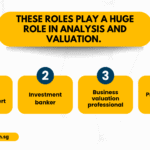Various Multiples Used in Company Valuation: Valuation multiples are financial calculation instruments that compare different businesses by evaluating one financial statistic as a ratio to another. Multiples are the ratios of one financial statistic (for example, share price) to another (i.e., Earnings per Share). It’s a simple way to figure out a company’s worth and compare it to other companies.
Quick Contact
Need Help?
Please Feel Free To Contact Us. We Will Get Back To You With 1-2 Business Days.
info@valueteam.com.sg
+65 9730 4250
Various Multiples Used in Company Valuation

BEST INDUSTRY PRACTICES
Understanding the concept of a valuation multiple, which is a prevalent valuation method, particularly for private companies, is critical to understanding company valuation.
A valuation multiple can evaluate a company’s worth using various performance metrics. Various Multiples Used in Company Valuation are
- Revenue
- Earnings
- Assets
- Industry-specific variables
1. EQUITY MULTIPLES
Equity multiples are used in investment decisions, particularly when investors are looking to buy minor stakes in companies. Some common equity multiples used in valuation analysis are listed below.
- Price Earnings Ratio – is the most widely used equity multiple; input data is readily available; calculated as the ratio of Share Price to Earnings per Share (EPS).
- Price/Book Ratio – is helpful if assets drive profits rather than anything else; calculated as the ratio of share price to book value per share.
- Dividend Yield – is a metric that is used to compare cash returns and investment forms. It is calculated as the ratio of Dividend per Share to Share Price.
- Price/Sales – used by businesses that lose money; simple estimates; calculated as the ratio of share price to revenue per share.
A financial analyst must consider that businesses have different levels of debt, which affects equity multiples.

2. ENTERPRISE VALUE (EV) MULTIPLES
Enterprise value multiples are the most suitable multiples to use when assessing a merger and acquisition because they reduce the impact of debt financing. Some common enterprise value multiples used in valuation analysis are mentioned below.
- Enterprise Value to Revenue Multiple – is a valuation multiple that divides the enterprise value (equity plus debt minus cash) by annual revenue to determine the value of a company. For early-stage or high-growth companies that do not yet have positive profits, the EV to sales multiple is widely used. It is slightly influenced by accounting differences, calculated as the ratio of Enterprise Value to Sales or Revenue.
- EV/EBITDA multiple – ratio compares a company’s Enterprise Value (EV) to its Earnings Before Interest, Taxes, Depreciation, and Amortization (EBITDA) (EBITDA). The EV/EBITDA ratio is a standard metric for comparing the relative worth of different businesses.
- EV/Invested Capital – is a ratio of Enterprise Value to Invested Capital used in capital-intensive industries.
- EV/EBITDAR – is an Enterprise Value to its Earnings Before Interest, Taxes, Depreciation, Amortization, and Lease Rentals (EBITDAR) used in the airlines’ industry.
DIFFERENT METHODS OF VALUATION MULTIPLES
There are two techniques for performing multiples analysis.
Comparable Company Analysis: is used to examine public corporations. These businesses are comparable to the highly regarded firm. For each organization, an analyst will gather information. Share values, market capitalization, capital structure, sales, EBITDA, and earnings are all included.
Precedent M&A Transactions: examines previous industry mergers and acquisitions (M&A). Investors will use it as a benchmark for the company’s worth.
Valuation Multiples Formulas
In certain circumstances, the following formulae determine small business valuation multiples by industry.
- EV/Revenue = Enterprise Value ÷ LTM Revenue
- EV/EBITDA= Enterprise Value ÷ LTM EBITDA
- EV/EBITDA = Enterprise Value ÷ LTM EBITDA
- P/E Ratio = Equity Value ÷ Net Income
- PEG Ratio = P/E Ratio ÷ Expected EPS Growth Rate
Benefits And Drawbacks of Using Multiples in Valuation
Valuation experts may accurately assess a company’s market value if they use a multiples business valuation market approach in their valuation study. Using multiples correctly might reveal a lot about a company’s financial health. In addition, business valuation multiples are essential since they provide important data for making investment choices. The ease with which most analysts may use multiples is due to their brevity.
However, since it reduces complex data to a single number, this ease of usage might be a drawback. This might lead to misunderstanding and make it challenging to analyze the impact of numerous circumstances.
Basic Principles of How to Apply Valuation Multiples
- Identify peers with comparable growth and ROI potential and use these peers to help determine your ROI and growth potential.
Finding suitable business valuation comparables differentiates competent veterans from newcomers. Financial specialists analyze a company’s industry first. The company’s annual report may mention competitors. After establishing a list of counterparts, the actual job begins.
Determine why each firm’s multiples differ from its counterparts: better products, more customers, recurring revenue, or economies of scale. ROI and growth rates will be higher if these strategic benefits are achieved.
It would help if you researched each company’s operations and finances, including what they sell, how they generate money, and their expansion plans. Unless you have experience, several firms won’t seem right to other businesses.
- Use multiples that look ahead.
Both valuation concepts and empirical evidence support basing multiples on projections rather than past results. If no reliable estimates are available, use the most recent historical data (for the last four quarters, not the previous fiscal year) and omit one-time events.
Empirical study shows forward-looking multiples are the better typical business valuation multiples to forecast future value. Jing Liu, Doron Nissim, and Jacob Thomas investigated NYSE, NASDAQ, and AMEX businesses. Historical earnings-to-price ratios were twice as dispersed as one-year prospective ratios.
Researchers found that forward-looking multiples improved pricing accuracy. To measure precision, they looked at each multiple’s median price error. Inaccuracy was 23% for historical multiples and 18% for one-year profitability. Using two-year estimates lowered pricing inaccuracy to 16%.
- Make use of multiples of enterprise value
P/E multiples have two restrictions. Most affected by capital structure. Unlevered P/E ratios grow with leverage when they surpass the cost of debt. A corporation with a high P/E may exchange debt for shares to boost its P/E. Restructuring and write-offs affect P/E ratios. P/E multiples are rare. AOL Time Warner wrote down $100 billion in 2002. Despite $6.4 billion in EBITDA, the company lost $98 billion. Losses nullified its P/E ratio.
EBITDA/EV might replace P/E. The capital structure affects this ratio less than others. It’s essential to evaluate the EBITDA business valuation because EBITDA shows investor profit; thus, the capital structure won’t alter company value. Lower capital cost variation increases multiples. In a business, valuation multiples by industry Growth and ROI affect EBITDA multiples.
CONCLUSION
The quickest way to determine a company’s worth is to use valuation multiples. This will assist the team in responding to the following questions:
- What is the current value of our company?
- What changes need in the business to improve its value?
- What is a reasonable price for another company?
- What is the relationship between current valuations and historical periods?




